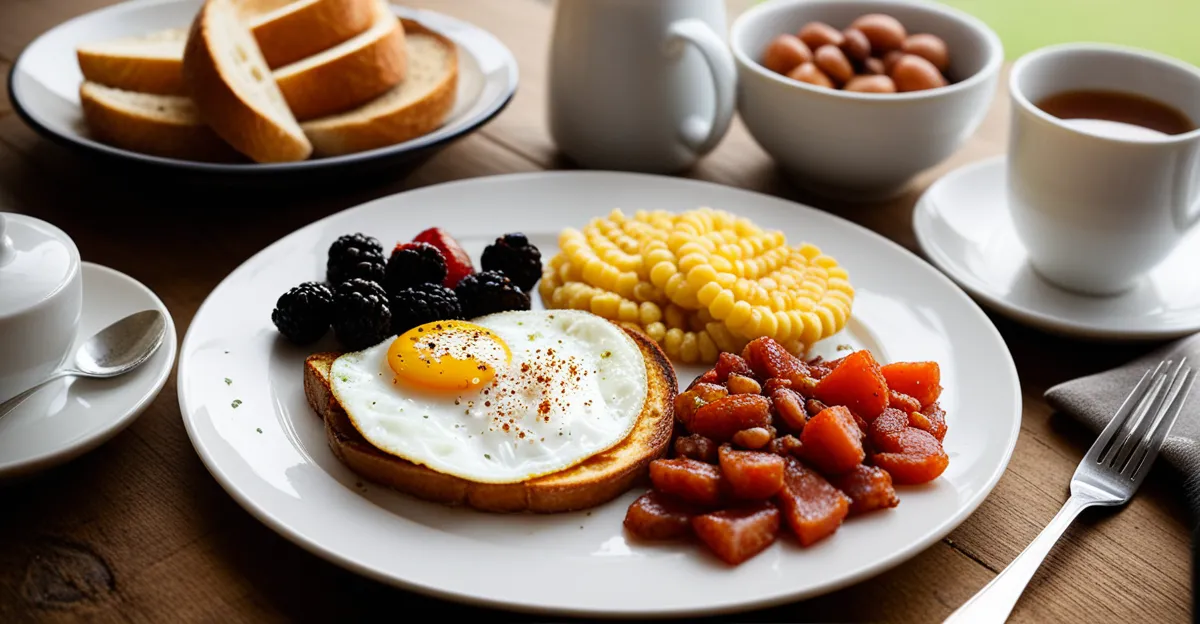Essential Ingredients for an Authentic English Breakfast
Crafting a traditional full English breakfast begins with selecting the right English breakfast ingredients to capture its classic flavor and texture. The essentials consist of eggs, crispy bacon, savory sausage, rich black pudding, plump baked beans, succulent tomatoes, earthy mushrooms, and golden toast. Each component plays a significant role in the overall experience, contributing to the hearty and balanced nature expected from this meal.
Quality truly matters when sourcing these ingredients. For example, choosing pork sausages with a good blend of seasoning and quality bacon can elevate your full English breakfast to something memorable. Opting for vine-ripened tomatoes and fresh mushrooms helps retain authentic taste and texture. When selecting black pudding, look for varieties with a balanced spice mix and texture to complement other elements on the plate.
Additional reading : How can you make a delicious spotted dick pudding from scratch?
Dietary considerations can be addressed without sacrificing authenticity. For those avoiding pork, substitute sausages and bacon with good-quality turkey or veggie alternatives designed to mimic traditional flavors. Baked beans can be selected in low-sugar versions or homemade using reduced salt recipes to suit health preferences. Eggs remain a non-negotiable staple but can be cooked to preference—fried, scrambled, or poached—to cater to individual tastes.
By focusing on these English breakfast essentials, you ensure that every bite embodies the rich, comforting appeal central to an authentic English breakfast experience.
In parallel : What Are the Key Ingredients That Define Traditional UK Cuisine?
Step-by-Step Cooking Methods
Mastering how to cook English breakfast involves timing each element perfectly to achieve a harmonious and satisfying meal. The traditional English breakfast recipe starts by heating the oven or keeping a warm spot for finished items, so all components stay fresh and hot.
Begin by cooking the sausages over medium heat, turning regularly until browned and cooked through—this usually takes about 12 to 15 minutes. Meanwhile, cook the bacon: opt for medium heat to render fat gently, achieving crispness without burning. Bacon can be cooked on a grill pan or under a grill for even texture. After the bacon and sausages are underway, prepare the mushrooms and tomatoes. Sauté the mushrooms in butter or oil until golden and tender, typically 5 to 7 minutes. For the tomatoes, grill or pan-fry halves for 3 to 4 minutes until softened but still juicy.
Next, warm your baked beans gently in a saucepan over low heat to prevent splitting and retain their rich flavor. Fry or scramble the eggs last, as they cook quickly and should be served immediately for best texture and taste. If using black pudding, slice into rounds and pan-fry each side until crispy, about 3 minutes per side.
For batch cooking or feeding a group, keep cooked items warm in a low oven (around 90°C/200°F) while completing the other components. This method ensures each element retains its individual texture and flavor without becoming soggy or overcooked.
Following these full English breakfast instructions helps deliver a flawless plate where every ingredient complements the next, preserving the authenticity and satisfaction that define this cherished meal.
Serving and Presentation
Creating a visually appealing and authentic serving English breakfast arrangement enhances the enjoyment of this classic meal. When presenting full English breakfast, balance is key—position the English breakfast essentials so each component is clearly visible and distinct on the plate. Typically, place the eggs centrally, surrounded by sausages, crispy bacon rashers, and slices of black pudding. Arrange grilled tomatoes and sautéed mushrooms alongside baked beans in small ramekins or neatly spooned beside the toast slices to retain the traditional look.
For an authentic feel, use a large, round plate to give ample space for each item without overcrowding. This traditional plating style allows diners to appreciate both the variety and colors of the ingredients, reinforcing the hearty, satisfying nature of the breakfast.
Accompaniments also play a role in the full experience. Commonly served with the meal are condiments such as brown sauce or English mustard, adding depth to the flavor. Tea, particularly strong English breakfast tea, or freshly brewed coffee are perfect warm beverages to complement the dish and complete the traditional British breakfast ritual.
Whether serving individually or family-style, keep portions generous but well-spaced. For family-style presentation, arrange the components on larger platters, allowing guests to help themselves, which encourages communal dining and adds to the sociable atmosphere. This method also speeds up service and keeps the meal dynamic.
Paying attention to these English breakfast plating details ensures your meal not only tastes authentic but also looks inviting—celebrating a true British culinary tradition.
Regional Variations of the English Breakfast
Understanding English breakfast regional differences enriches the appreciation of this iconic meal’s diversity. While the traditional full English breakfast includes staples like eggs, bacon, sausage, baked beans, tomatoes, mushrooms, black pudding, and toast, regional variations highlight unique local ingredients and preparation styles.
The Scottish breakfast, for instance, incorporates distinctive elements such as haggis, tattie scones (potato scones), and sometimes square sausage—differing notably from the English version. Black pudding in Scotland often has a spicier profile and firmer texture. These variations emphasize local flavors and maintain the hearty and satisfying nature central to the full breakfast concept.
Similarly, the Irish breakfast typically emphasizes white and black puddings along with soda bread, offering a slightly different texture and taste compared to the English or Scottish versions. Irish sausages tend to be coarser and sometimes include a sweeter seasoning mix. Tomatoes and mushrooms remain common, ensuring continuity with the traditional full English breakfast, but local touches enhance authenticity.
Adapting your English breakfast for regional authenticity involves selecting these characteristic ingredients while preserving core components. For example, substituting standard sausages with Scottish square sausage or adding haggis creates a genuine experience of the Scottish breakfast. For an Irish twist, integrating soda bread alongside classic toast and including both black and white pudding achieves an authentic feel.
Recognizing these British breakfast types and their regional nuances allows enthusiasts to tailor their cooking and presentation, celebrating the diversity within this beloved meal tradition.
Sourcing Authentic Ingredients and Helpful Tips
Choosing where to buy English breakfast ingredients is crucial for an authentic experience. Specialty stores or butchers in the UK often provide the best sourcing British breakfast items, ensuring freshness and traditional flavor. For example, high-quality pork sausages and proper black pudding are more readily available from local butchers than in generic supermarkets. When it comes to baked beans, selecting those from trusted British brands helps preserve the familiar taste expected in a traditional full English breakfast.
In addition to physical stores, some online retailers specialize in British foods, offering carefully curated selections of English breakfast essentials. These vendors often provide detailed product descriptions, enabling you to choose items that fit both taste and dietary needs. When ordering online, check shipping times and storage recommendations to maintain the integrity of perishable goods.
Maintaining ingredient freshness is another important factor. Store sausages and bacon in the coldest part of the refrigerator and consume them within recommended time frames to avoid compromising flavor. For items like mushrooms and tomatoes, opt for those that are firm and free from blemishes. Proper storage extends to bread and baked beans; toast is best prepared fresh, but sturdy bread varieties can be frozen and toasted later to save time.
For those concerned with time constraints, consider simple English breakfast tips such as pre-slicing black pudding or pre-washing mushrooms to streamline cooking. Batch-cooking bacon or sausages and freezing portions can also speed up meal preparation without sacrificing quality.
By focusing on authentic sources and practical storage, home cooks can elevate their English breakfast ingredients selection, guaranteeing a flavorful and genuine full English breakfast every time.






